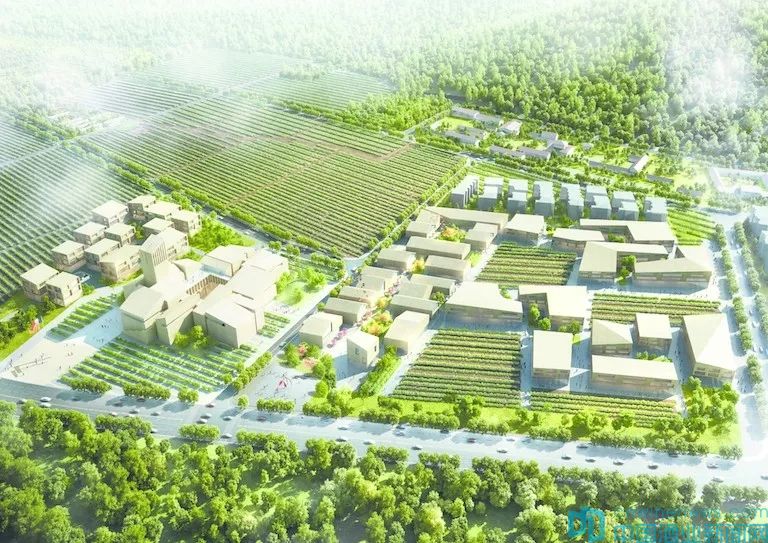Clustered buildings, cubist lines, structures in stone — the iconic medieval village of Saint-Emilion, which is a UNESCO world heritage site, has provided the main source of inspiration for the future Universal Wine Museum in Beijing. Launched in partnership with the Cité du Vin wine museum in Bordeaux, France, the project aims to become the main centre in China and Asia for all things relating to wine.

Beijing’s vast Universal Wine Museum will be ranged around a tower inspired by church architecture. (Photo: AFP/ ArchitectureStudio_1)
Located in Zhong Pu Hui Wine Village 40 kilometres from the Forbidden City, an 18,000-square-metre site has been reserved for the future pedagogical resource, which will offer a comprehensive introduction to oenology and wine culture.
Drawing extensively on the architecture of Saint-Emilion, the new complex — which will be set in a sea of vines — will feature a tower and a cloister. Visitors to the future tourist attraction will be invited on a tour covering 6,700sqm that will elucidate all the aspects of winemaking, as well as the long history of a drink that is for many Western civilisations a key aspect of the art of living.
Like the Cité du Vin in Bordeaux, the new facility will offer multi-sensory exhibits to educate visitors on all aspects of wine tasting, including the balance of acidity and sweetness and the expression of tannins. It will also be home to a school, where students can embark on courses to develop their understanding of how to pair and serve wine, a cellar and a gourmet restaurant.

A bird’s eye view of Beijing’s Universal Wine Museum. (Photo: Architecte Studio)
“The concept of the museum is the same as the Cité du Vin, but its DNA has taken a different form,” points out Philippe Massol, the managing director of Fondation de la culture et des civilisations du vin. “The tour will follow an established route, because many Chinese visitors will benefit from a more guided approach, as opposed to the Cité du Vin in Bordeaux, where visitors come and go as they please.”
Another important difference will be the absence of interactive pedagogical installations. “Chinese tourists favour more concrete exhibits,” explains Massol.
The Beijing Universal Wine Museum aims to welcome half a million visitors in its first year. Building work is set to begin next April. It will be the first step in a plan that has been developed over the last two years, points out the museum’s president and founder, Weixang Tang, at a presentation of the project.
The museum will be just one destination in a wine village extending over eight square kilometres, where travellers will have the opportunity to spend several days exploring the world of Bacchus. There are plans for a luxury hotel to be built at the foot of Mount Wulan, while more budget-conscious visitors can opt for a second, more affordable establishment.
Visiting families can reserve weekend cottages at the village’s educational farm and riding stables. Last but not least, there will be a mall with stores and restaurants, which will once again be inspired by French urban architecture.
Although China is more traditionally oriented towards beer and strong liquor like maotai, wine is increasingly popular in the Middle Kingdom. According to the 2018 Vinexpo study, the Chinese market accounts for 1.46 billion litres of wine per year, which makes it the world’s fifth largest. It is also worth noting that the current level of consumption is expected to rise by 18.5% by 2021, just in time for the opening of Beijing’s new Universal Museum of Wine.
北京葡萄酒博物館2021年面世
到2021年,一座以波爾多“葡萄酒之城(La Cité du Vin)”為模型的葡萄酒博物館將在北京房山中葡匯葡萄酒小鎮建成。該項目與法國波爾多Cité du Vin葡萄酒博物館共同發起,投資達6650萬美元,旨在打造成中國和亞洲的葡萄酒文化中心。
成群的建筑物,立體派的線條,石質的結構——作為聯合國教科文組織世界遺產的中世紀圣埃美隆小鎮,為未來的北京葡萄酒博物館提供了主要的靈感來源。距故宮約40公里的中葡匯葡萄酒小鎮,預留了18,000平方米的場地用于未來的葡萄酒文化展示和教育。
新建筑群將廣泛采用圣埃美隆的建筑風格,坐落于一片葡萄樹中,并設有塔樓和回廊。游客將可在占地6,700平方米的空間里展開一場葡萄酒之旅,體驗與葡萄酒釀造有關的所有方面,了解葡萄酒這一在許多西方文明中作為生活藝術重要組成部分的飲品的悠久歷史。
像波爾多的Cité du Vin一樣,新博物館也將提供多感官展示,讓游客體驗葡萄酒的各個方面,包括酸度和甜度的平衡以及單寧的表達。它還將是一所葡萄酒學校,學生們可以通過參加課程來加深對餐酒搭配、侍酒知識的了解,此外,它還將兼具酒窖和美食餐廳的功能。
“北京葡萄酒博物館的概念與波爾多葡萄酒博物館相同,但其DNA卻呈現不同的形式,” 管理La Cité du Vin的葡萄酒文化與文明基金會總經理Philippe Massol說。“這一葡萄酒之旅將遵循既定路線,因為許多中國游客更傾向于引導性參觀,而在波爾多葡萄酒博物館,游客可以隨意游覽。”
另一個重要的區別是沒有互動式的教學裝置。“中國游客偏愛更具體的展覽品。” Massol解釋道。
波龍堡集團董事長唐衛星是北京葡萄酒博物館建設的負責人。該博物館的目標是在第一年吸引50萬游客。
盡管中國在傳統上更傾向于啤酒和烈性酒,但葡萄酒近年來在中國越來越受歡迎。根據2018年Vinexpo的研究,中國市場每年的葡萄酒消費量為14.6億升,為世界第五大葡萄酒消費國。值得注意的是,到2021年北京葡萄酒博物館建成時,中國的葡萄酒消費水平預計將增長18.5%,從而成為僅次于美國的全球第二大葡萄酒市場。
來自:法新社
編譯:華夏酒報記者徐菲遠

